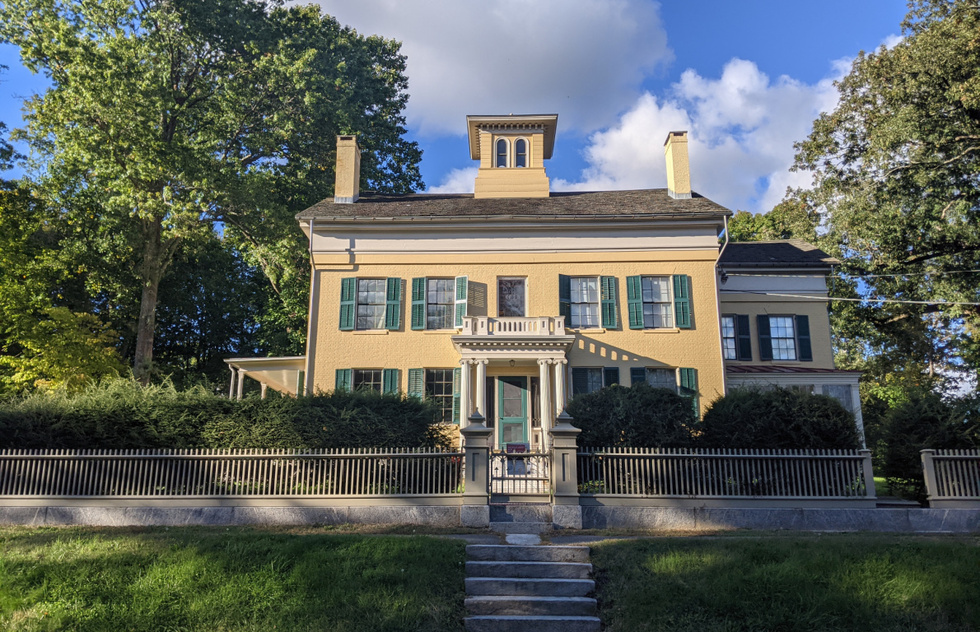The tired old story about Emily Dickinson being a wraithlike recluse has gotten a much-needed revision in recent years, thanks to scholars, moviemakers, and, above all, the three seasons of Dickinson on Apple TV+, which presents its subject as rebellious and modern rather than withdrawn and otherworldly.
These fresh reevaluations and reimaginings have helped restore to the poet’s reputation elements that were in her poetry all along—humor, irreverence (especially with regard to religion and gender), desire, an expansiveness that transcends yet somehow derives from quotidian routine, and a daringly original, downright radical approach to verse.
And now the house where Dickinson was born in 1830, died in 1886, and, in between, wrote roughly 1,800 astonishing poems has at last been restored to what feels like an apt setting for all that quiet passion (to borrow the title of the 2016 film in which Cynthia Nixon plays the poet).
Having closed amid the onset of the Covid-19 pandemic in 2020, the Emily Dickinson Museum reopened the Homestead, as the Dickinson family’s butter-yellow residence in Amherst, Massachusetts, is known, more than two years and $2.5 million later, unveiling a decidedly more lived-in look than before.
The restoration aims to re-create the way the interior might have appeared in the mid-1850s, when the poet was in her mid-20s and busy prints on carpets and wallpaper were evidently all the rage in New England.
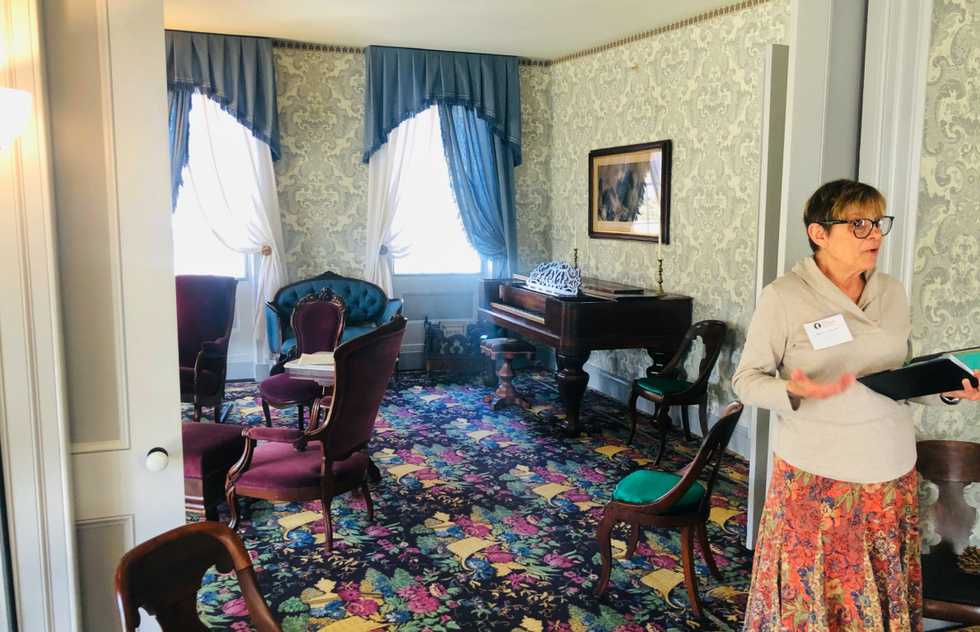 (Downstairs parlor at the Homestead, part of the Emily Dickinson Museum in Amherst, Massachusetts | Photo credit: Zac Thompson)
(Downstairs parlor at the Homestead, part of the Emily Dickinson Museum in Amherst, Massachusetts | Photo credit: Zac Thompson)
That was the period when the poet’s writing got going in earnest while she lived in the Homestead with her parents and younger sister, Lavinia. Brother Austin Dickinson and his wife Susan (Emily’s close friend and possible love interest) lived next door at the Evergreens—now also part of the Emily Dickinson Museum, though that house’s decaying, frozen-in-time interior is currently closed while the structure undergoes repairs.
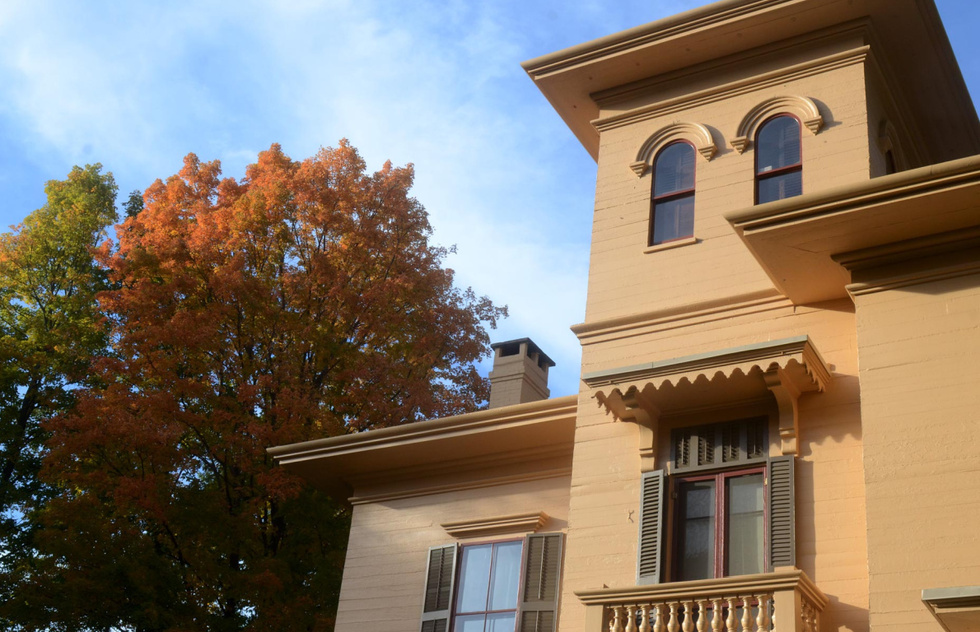 (The Evergreens, part of the Emily Dickinson Museum in Amherst, Massachusetts | Photo courtesy of the Emily Dickinson Museum)
(The Evergreens, part of the Emily Dickinson Museum in Amherst, Massachusetts | Photo courtesy of the Emily Dickinson Museum)
For the Homestead’s restoration, a collection of original and replica furnishings has been supplemented with scores of set pieces and atmospheric props donated by the Apple TV+ series after shooting wrapped in 2021. (The show relied on studio re-creations of the Homestead rather than filming on location.)
The finished result of the makeover is markedly different from but much more historically accurate than the interior's previous appearance, according to Jane Wald, the Emily Dickinson Museum’s executive director.
For comparison, here's a photo of the Homestead's interior taken several years before it was gussied up:
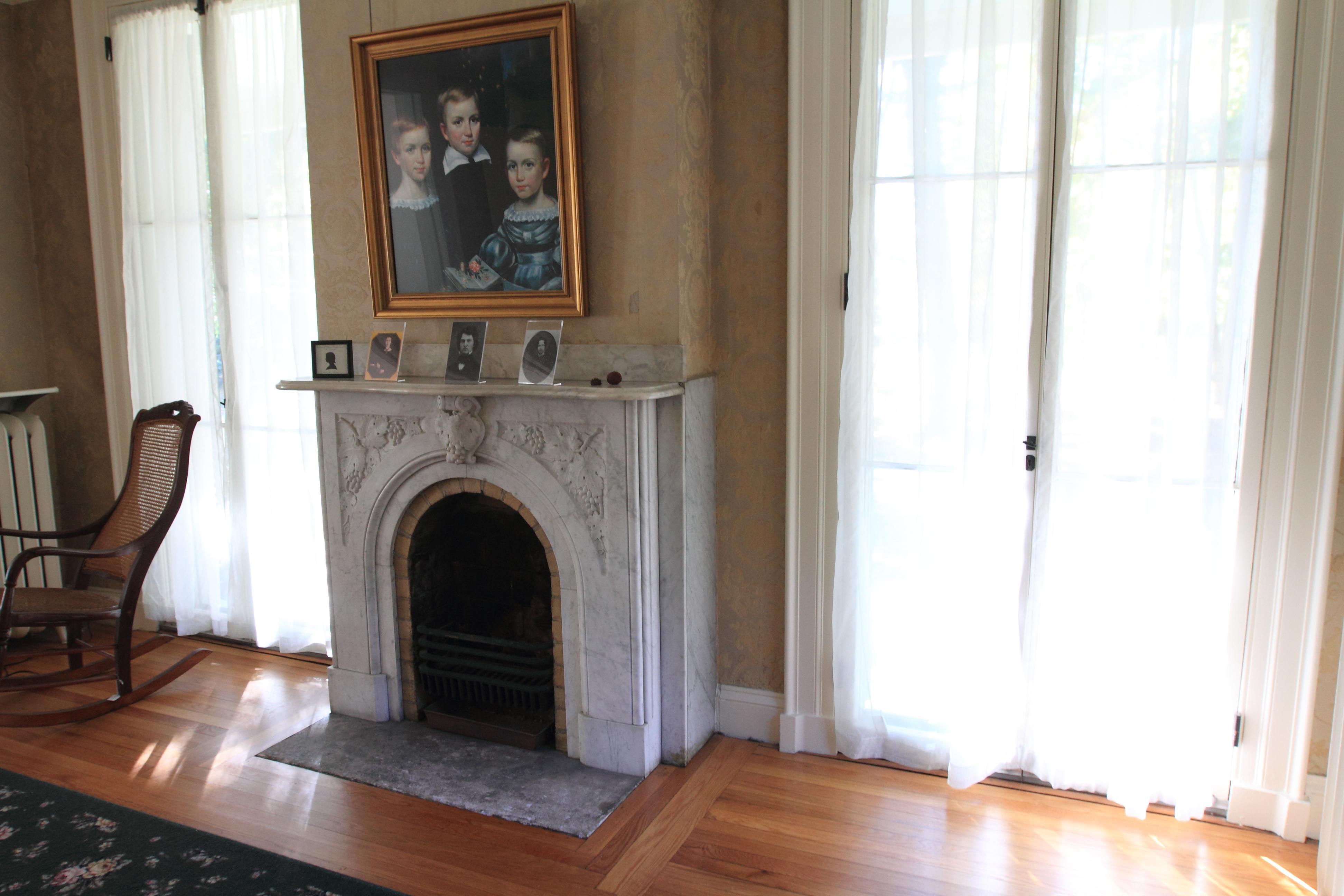 (Parlor of the Emily Dickinson home in Amherst, Massachusetts, before restoration | Photo credit: Vincent DeWitt)
(Parlor of the Emily Dickinson home in Amherst, Massachusetts, before restoration | Photo credit: Vincent DeWitt)
Acquired by Amherst College in 1965 and turned into a museum three decades later, the pre-renovation residence was characterized by “sparsely furnished rooms and neutral décor,” Wald says, that “gave a false impression of daily life at the Homestead and made it difficult to see the 19th century.”
Now, on the other hand, some of the floor and wall coverings look like they were designed to be seen from space.
In the downstairs parlor, for instance, a replica of Emily’s piano stands amid walls papered with a swirling pattern resembling blue-gray amoebas. Underfoot, an almost garish carpet bears a repeating motif of yellow baskets overflowing with huge sprays of blue and magenta blossoms.
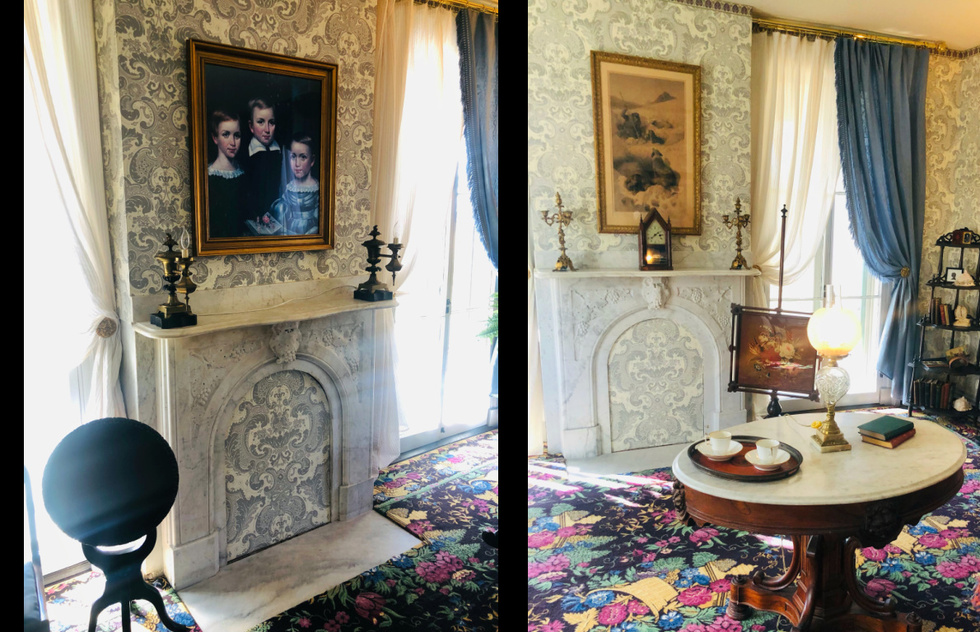 (Same room as above, today | Photo credit: Zac Thompson)
(Same room as above, today | Photo credit: Zac Thompson)
It’s a lotta look. But the museum’s researchers contend that’s how the Dickinson family wanted things—conclusions based on painstaking analysis of surviving architectural features as well as letters and other documents from and about the family.
Walking through the house on the guided 45-minute tour, you’ll spot a bunch of other items, many from the Dickinson series, that evoke the family’s day-to-day lives, such as stray copies of the Springfield Republican and other periodicals, musical instruments, books, reading glasses, and scraps of handwritten verse.
Harvard University’s Houghton Library, located about 90 miles to the east, has many of the home’s key original artifacts, including the poet’s writing table, her papers, and the family’s book collection; free public tours of Houghton’s Dickinson Room are offered at Harvard on Fridays at 2pm.
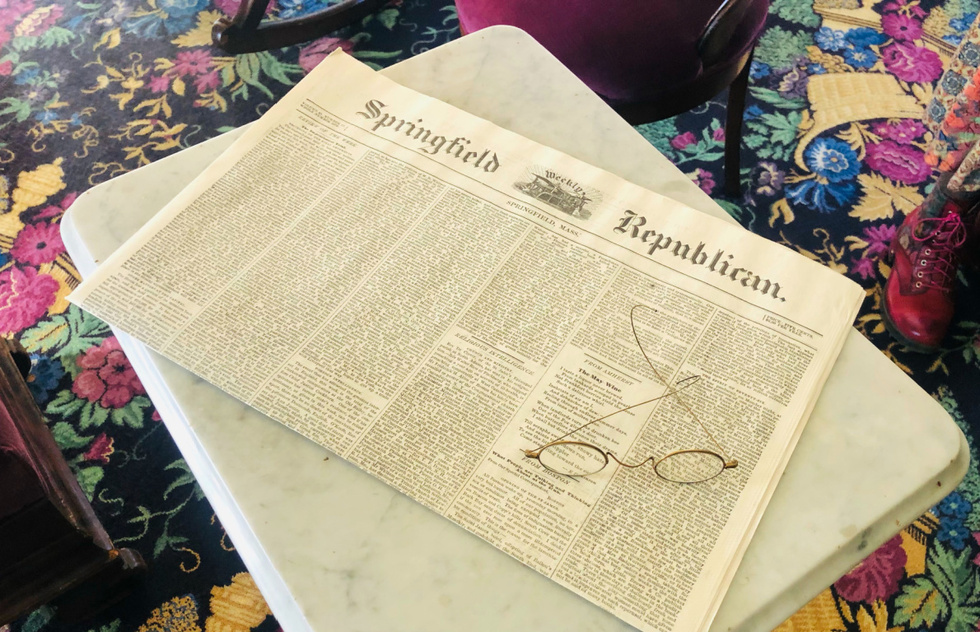 (Inside the Homestead, part of the Emily Dickinson Museum in Amherst, Massachusetts | Photo credit: Zac Thompson)
(Inside the Homestead, part of the Emily Dickinson Museum in Amherst, Massachusetts | Photo credit: Zac Thompson)
The objects on display at the Homestead evoke a bustling, intellectually active household and, along with the surprisingly maximalist design aesthetic, they give the lie to the bloodless Belle of Amherst cliché unwittingly reinforced by the Homestead’s former starkness.
Pre-restoration, the interior “wasn’t doing as good a job as it could of providing an experience of Dickinson’s poetry in the place it was written,” Wald told us.
As literary pilgrimage sites go, the Homestead is an especially potent environment for such an experience, given that Dickinson confined her work to these premises almost entirely, not only writing her poems here but also keeping most of them locked away and unpublished during her lifetime.
The museum’s renewed efforts to connect Dickinson’s work to the life of the house go beyond interior design. On a recent visit to the Homestead, the tour guide on duty quoted liberally from the poems, distributed copies of the handmade booklets Dickinson created, and invited tourgoers to listen to how the sounds of the building carry to the places where Dickinson might have done her writing.
We were encouraged as well to keep an eye out for the inspirational possibilities of the surrounding garden, always a strong influence on Dickinson. As the author put it in her playfully blasphemous edit on the doctrine of the Trinity:
- In the name of the Bee —
- And of the Butterfly —
- And of the Breeze — Amen!
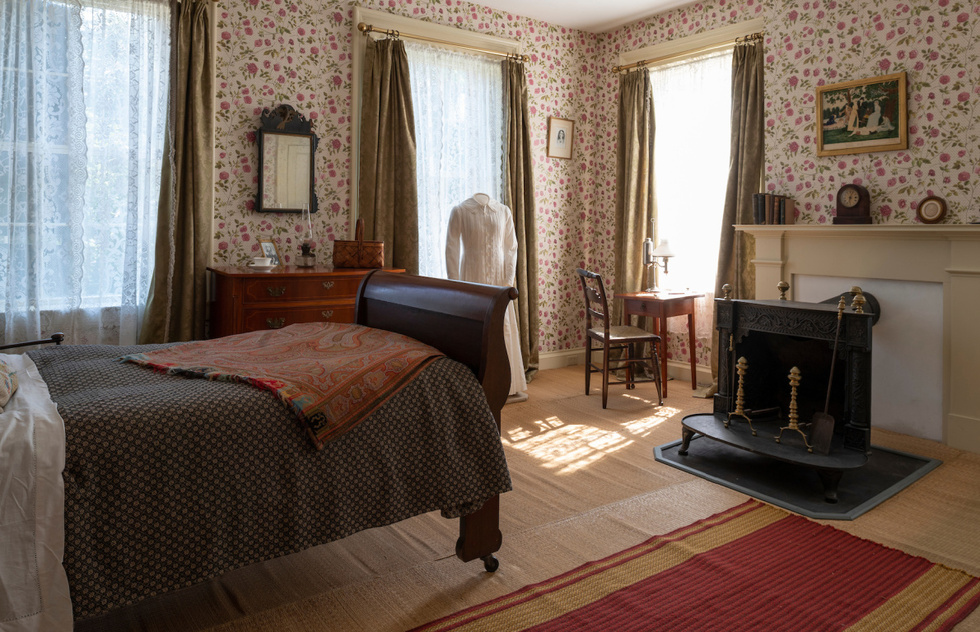 (Emily Dickinson's bedroom at the Homestead in Amherst, Massachusetts | Photo courtesy of the Emily Dickinson Museum)
(Emily Dickinson's bedroom at the Homestead in Amherst, Massachusetts | Photo courtesy of the Emily Dickinson Museum)
Dickinson’s upstairs bedroom remains pretty much as it has looked since an earlier restoration completed in 2015, but the changes elsewhere in the house now do a good job of priming your imagination for entering the modest but “mighty room” (in Dickinson’s phrase) and making it feel of a piece with the rest of the home rather than a shut-in’s shut-away refuge.
A reproduction of one of Dickinson’s plain white dresses floats in the middle of the room (don't worry—the garment is actually on a dress form), not far from a replica of the poet’s teensy writing desk under a window facing westward. The wallpaper features rose blooms.
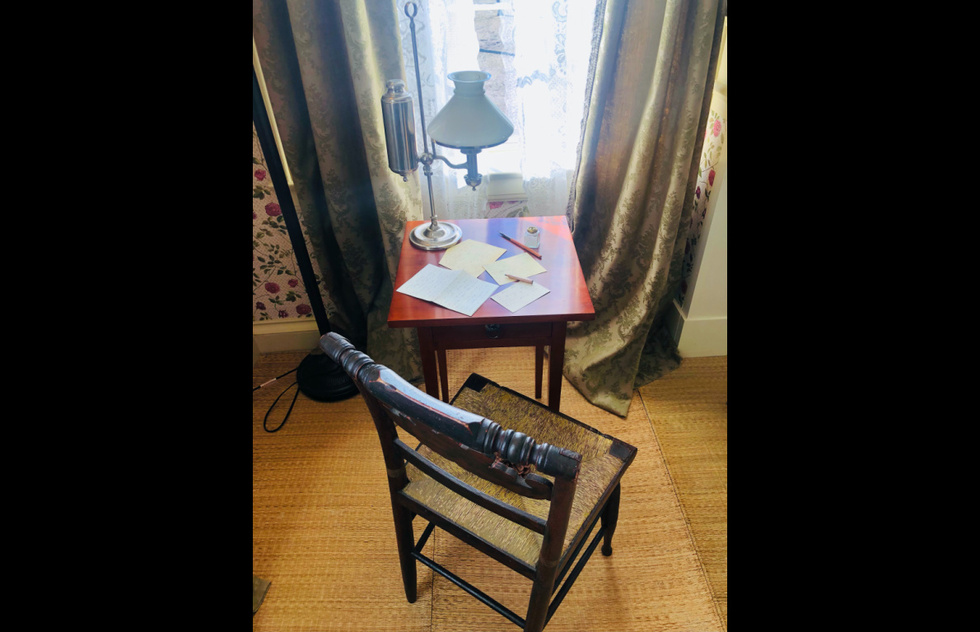 (Replica of Emily Dickinson's writing desk in her bedroom at the Homestead in Amherst, Massachusetts | Photo credit: Zac Thompson)
(Replica of Emily Dickinson's writing desk in her bedroom at the Homestead in Amherst, Massachusetts | Photo credit: Zac Thompson)
From this pivotal yet unexpectedly cozy locus of seismic verse, the tour ends on a new grace note: a visit to the previously closed-to-the-public bedroom where Emily’s ailing mother spent the final years of her life.
The tour’s last stop is most notable for its proximity to the preceding one. The short passageway that links the sickroom to the writer’s bedroom supplies yet another reminder of the poet’s intimate familiarity with the mysteries of life and death that shaped her unique genius.
To visit the interior of the Homestead at the Emily Dickinson Museum, located at 280 Main St. in Amherst, Mass., visitors must purchase tickets for the 45-minute guided tour. General admission costs $16. Purchase tickets in advance at EmilyDickinsonMuseum.org.





